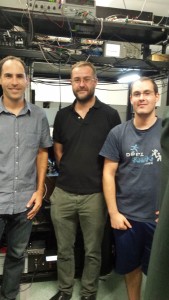Back in Term 1 my initial reaction upon hearing our Physics EEI (Extended Experimental Investigation) topic was “there’s no goddamn way I’m doing an assignment on eskies.”
When our topic is thermal physics, surely there would be something that’s a bit more interesting than the physics of eskies. So naturally, I do my research, looking necessarily complex topics as you do, when an idea came about. An idea that you sorta chew on at first.
In Grade 11 I did work experience at the University of Queensland. Now that might sound impressive but to be honest, as fun as 3rd year quantum lectures are, they don’t outweigh the mind crushing complexity of Matlab. I dread using that program, seriously.
But anyway, I was being facilitated by the Condensed Matter Physics guys, and they showed me around their labs and it was pretty cool. Lots of lasers. Their area of expertise is something called Bose-Einstein Condensation. Now, if you google this and read the wikipedia page, chances are you won’t understand a single word. I still don’t understand the wikipedia page.
But essentially, Bose-Einstein condensation is getting matter to really really cold temperatures. Like, colder than liquid nitrogen. Colder even than outer space. So this is running through my head while everyone else is planning out their esky experiments, and I’m thinking,Well…thermal physics – so cold and hot things right? BECs are cold. So…
I tell the other guys, but they laugh it off.Then I tell my teacher and he says “Sure, why not?”
So I go ahead and email my work experience contact about it. <
And voilà it worked out!
After doing background researching and figuring out my variables and experiment ideas I got to UQ again for a day of experimentation. I wasn’t sure what to expect but they were really cool and basically let me play with variables of the actual physical experimental BEC setup for the better half of a day. It was pretty cool, even if it was just typing numbers and using a program. But considering that no less than a meter behind me was a machine composed of lasers and coils condensing clumps of rubidium to temperatures around 1 nano-kelvin (a billionth of a Kelvin)…well it was pretty cool.

There’s something novel about understanding a few sentences or even a paragraph of a physics PhD. Especially when the topic is so cool. Like no, really, it’s fascinating.
When you’re playing with a Bose-Einstein Condensate, you’re manipulating the coldest matter in the universe. It’s colder than anything on Earth by far, and much colder than outer space even. And the way you get it so cold is so counter-intuitive – with lasers! (That’s the photon recoil I mentioned). Then you hit it with radio waves to get it even colder! It’s easy to forget how utterly weird and fascinating the whole thing is when you’re just typing in numbers.
If you make a proper BEC though, you start to notice some very odd things. Usually you can tell atoms apart because they have slightly different properties, but in a BEC they’re all the same. You’re left with a clump in which you can’t point to its parts. They call this a superatom, because it behaves like one big atom.
BECs are also super fluids. You can find really cool videos on superfluidity with liquid helium which shows just how weird it is. With the liquid experiencing zero viscosity, it can do things like creep up the walls of the container and drip off.
A lot of people, after hearing stuff like that usually ask, “Well, what can it be used for?” Which is a fair question, despite the fact that you’d probably need a PhD in quantum atom optics to understand a legitimate answer. Unfortunately, there aren’t any commercial uses for BECs (yet), but that doesn’t mean that they aren’t important. In fact, they are one of the most important things in physics right now. Their use in research ranges from quantum computing to simulation of turbulence. So yeah, nerdy things right now, but who knows? Maybe you’re computer will one day have a little condensate in it to run all the quantum circuitry?
-A
Leave a Reply